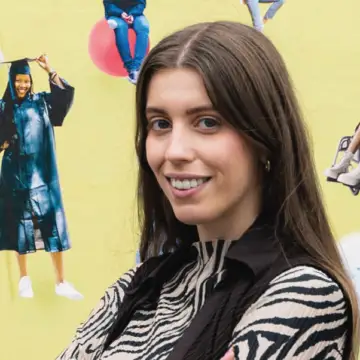As a creative, you’ve probably been there: scrolling through endless opportunity listings, applying to everything that seems remotely relevant, and feeling emotionally drained by the constant cycle of applications and rejections. The creative world is full of opportunities, but without clear boundaries, the application process can become a soul-crushing exercise that leaves you burned out and disconnected from your actual creative work.
Applying to creative opportunities doesn’t have to burn you out. With the right boundaries in place, you can create a sustainable practice that aligns with your values, protects your energy, whilst actually improving your chances of success.

Why Creative Opportunity Boundaries Matter
Without boundaries around creative applications, you’re likely experiencing:
- Constant rejection fatigue that affects your self-worth
- Spending more time applying than creating
- Saying yes to opportunities that don’t align with your goals
- Feeling scattered and unfocused in your creative practice
- Burnout from the emotional rollercoaster of applications
When you create clear boundaries around how, when, and what you apply to, you transform applications from a desperate scramble into an intentional practice that serves your creative career.
What is a Creative Opportunities Manifesto?
We’ve created this blog so you can put your boundaries in place through a fun creative exercise: creating a manifesto. A manifesto is a personal declaration of your principles and intentions – a set of guidelines that reflect your values and help you make decisions under pressure. When it comes to creative opportunities, your manifesto becomes your North Star, preventing you from making reactive decisions that compromise your creative practice or well-being.
Think of this as an exercise in intentional career building. As you read through each section below, consider it a manifesto prompt that helps you define your own boundaries. By the end, you’ll have a clear framework for approaching opportunities with confidence and purpose, rather than confusion and overwhelm.
Find the Best
Creative Opportunities
From competitions, to grants, and open calls — discover opportunities that fuel your creativity.
Your Creative Opportunities Manifesto: 6 Essential Boundaries
1. The Reward Boundary
Ask Yourself: What is the most valuable reward I need right now?
This is perhaps the most crucial boundary to establish. At different stages of your creative career, you’ll need different types of rewards. Early in your career, strategic exposure might be more valuable than money. Later, you might prioritize financial compensation or prestige. The key is being honest about what you actually need right now, and not what you think you should want.
If you need money, be specific about the amount that makes applying worthwhile. £100 might be worth it for a day’s work, but not for a month-long project. Ask yourself: What will this money go towards? Your creative practice, a research trip, rent, studio space? This helps you evaluate if the financial reward serves your larger creative goals.
If you need exposure, remember that not all exposure is created equal. Define what “valuable exposure” means for your career right now. Consider the following:
- Audience size and alignment (1,000 engaged followers vs. 100,000 random viewers)
- Industry recognition (curated by respected institutions vs. anyone can participate)
- Portfolio building potential (does this elevate your work presentation?)
- Network expansion (will this connect you with collaborators or mentors?)
Create your boundary:
- Define your primary reward need right now and the minimum threshold that makes applying worthwhile
- Create an “exposure audit” checklist: “Will this genuinely reach my ideal audience and advance my career?”
- Set a ratio for balancing different types of rewards: “I’ll apply to one unpaid opportunity for every three paid ones”
- Consider the full value package: sometimes a £200 prize plus an exhibition equals more value than a £1000 prize alone.
For Example: “I will consider unpaid opportunities only if they provide access to my target audience of emerging collectors, offer substantial portfolio value through professional documentation, or connect me with curators I want to work with. For paid opportunities, I need a minimum of £500 to make the application time worthwhile.”
2. The Fee Boundary
Ask Yourself: What is my top line for an application fee?
Application fees have become increasingly common in the creative world, but they shouldn’t be treated as a necessary evil. Every fee you pay is an investment in your creative career. And like any investment, you need clear criteria for what makes it worthwhile. Without boundaries around application fees, you can easily spend hundreds of pounds a year on opportunities that don’t align with your goals or offer adequate returns.
The key question isn’t whether you should ever pay application fees, but rather: when does the potential reward justify the cost? A £10 fee for a chance at a £10,000 prize and major exhibition might be worth it. A £50 fee for a small online feature probably isn’t. Here are some red flags to watch out for:
- Unusually high fees relative to the prize or recognition offered
- Vague descriptions of what the fee covers
- Multiple fee tiers that feel designed to extract maximum payment
Before applying to any opportunity with a fee, it’s worth checking if the opportunity is legitimate to ensure your money is well spent.
Create your boundary:
- Set an annual application fee budget (e.g., £200 per year) so you’re not making emotional decisions in the moment
- Create a cost-benefit analysis: fee amount vs. potential reward vs. likelihood of success
- Establish a maximum fee threshold beyond which you won’t apply regardless of the opportunity
- Consider the organisation’s reputation and track record of actually delivering promised rewards
- Factor in your current financial situation – never pay application fees if it means skipping meals or rent
For Example: “I will budget £150 per year for application fees, with a maximum of £25 per individual opportunity. I will only pay fees for opportunities where the potential reward is at least 10 times the fee amount, and only for organisations I’ve researched and trust to deliver on their promises.”

3. The Application Volume and Time Boundary
Ask Yourself: How many opportunities can you realistically apply to in a month?
Quality beats quantity every time. Rushing through multiple applications creates generic submissions that rarely stand out. More importantly, applications should enhance your creative work, not replace it. Without clear limits, you can easily spend more time applying than creating.
You can approach this boundary in two ways: volume-based or time-based. With a volume-based approach, you set a monthly application limit (e.g., 5 opportunities max) and ensure each gets thorough research and customisation. Alternatively, a time-based approach means dedicating specific hours per month to applications (e.g., 5 hours total) and sticking to it – this prevents overthinking and forces prioritisation.
Create your boundary:
- Calculate how long a strong application actually takes you
- Factor in your other creative work and life commitments
- Block out non-negotiable creative time that applications cannot invade
- Set “application windows” – specific times for opportunity research and submissions
- Create a quality checklist to ensure each application meets your standards
For Example: “I will apply to a maximum of 5 opportunities per month, spending no more than 2 hours per application. I protect 20 hours per week for creative work and will only work on applications during my designated Tuesday and Thursday afternoon slots.”
4. The Association Boundary
Ask Yourself: Who will you and won’t you work with?
Not every opportunity is worth pursuing, regardless of pay or exposure. The organisations and people you associate with become part of your creative reputation and can impact your career trajectory. Having clear standards for collaborators protects both your values and your professional standing.
Your association boundaries should reflect your core values and career goals. Consider what types of open calls and organisations align with your creative vision, and be equally clear about what doesn’t. This isn’t about being precious – it’s about being strategic. Understanding what makes an opportunity right for you can help you make better decisions about which opportunities to pursue.
Create your boundary:
- Define 3-5 core values that must align with any opportunity you pursue
- Create a “red flags” list of warning signs to avoid (poor communication, unrealistic timelines, values misalignment)
- Research organisations thoroughly before applying to check their track record and reputation
- Consider the long-term impact: would you be proud to have this association on your CV in five years?
For Example: “I will only apply to open calls by organisations that demonstrate clear communication, respect for creative timelines, and align with my values around sustainability and social justice. I will not work with organisations that have a history of not paying artists or that conflict with my environmental commitments.”
5. The Feedback Boundary
Ask Yourself: What are my boundaries around getting feedback for opportunities?
Feedback on applications can be incredibly valuable for growth, but it’s rarely guaranteed. Without clear expectations, you might feel disappointed or shortchanged when opportunities don’t provide the closure you’re seeking. The key is deciding upfront how important feedback is to your process and planning accordingly.
Consider what feedback actually does for you: does it help you improve future applications, or does it sometimes create more confusion and self-doubt? Some creatives thrive on detailed feedback, while others prefer to move forward without dwelling on rejections. Neither approach is wrong – what matters is knowing which works for you.
Create your boundary:
- Decide if feedback is essential for your growth or a nice-to-have
- Set clear expectations by asking about feedback policies before applying
- Create a plan for how you’ll handle both useful and unhelpful feedback
- Consider whether lack of feedback will affect your relationship with the organisation
For Example: “I always ask about feedback policies before applying. If feedback isn’t available, I’m comfortable moving forward without it. When I do receive feedback, I’ll take 48 hours to process it before deciding how to act on it.”

6. The Emotional Resilience Boundary
Ask Yourself: Do you have a framework for handling rejection?
Rejection is inevitable in creative work, but it doesn’t have to derail your confidence or creative practice. The difference between creatives who thrive and those who burn out often comes down to how they process rejection. Without a clear framework, each “no” can feel like a personal verdict rather than simply information about fit and timing.
The goal isn’t to become immune to rejection, it’s to develop a sustainable way of processing it that allows you to keep creating and applying. This means having practical strategies for the immediate emotional impact as well as longer-term perspective tools. Understanding how to thrive from rejection can help you build resilience in your creative practice.
Create your boundary:
- Develop a post-rejection ritual that helps you process emotions healthily
- Set a time limit for how long you’ll dwell on any single rejection
- Create a “rejection collection” mindset – viewing rejections as data, not verdicts
- Build a support system for processing particularly difficult rejections
- Establish what actions you’ll take after rejection (rest, create, apply elsewhere)
For Example: “When I receive a rejection, I allow myself 24 hours to feel disappointed. Then I add it to my ‘rejection collection’ as proof I’m putting myself out there, review what I learned, and return to my creative work. I will not let any single rejection define my worth as a creative.”
Creating Your Personal Manifesto
Now it’s time to create your own creative opportunities manifesto. Here are a few prompt questions which may help get you started:
The most valuable reward I need right now is___
I will consider unpaid opportunities only when___
I am willing to spend up to £___ on application fees per year, and only for opportunities that___
I will apply to a maximum of ___ opportunities per month OR dedicate ___ hours per month to applications because___
I will only work with people/organisations who___
When it comes to feedback from opportunities, I will___
When faced with rejection, I will___

Putting Your Manifesto into Practice
- Write your manifesto using the template above
- Post it in your workspace where you’ll see it when applying to opportunities
- Review it monthly and adjust as your career evolves
- Track your applications to see how your boundaries affect your success rate
- Celebrate your progress when you stick to your boundaries
When finding the best creative opportunities for your creative practice, refer back to your manifesto to ensure each application aligns with your boundaries.
The Long-Term Benefits
Better boundaries create better applications, which create better opportunities – a self-reinforcing cycle for sustainable creative success. When you consistently apply your manifesto, your creative practice stays protected, your confidence grows, and opportunities align with your actual career goals. Your creative practice is a marathon, not a sprint, and your creative opportunity boundaries are what will help you go the distance.
Your manifesto is a living document that will evolve with your creative career, but having it in place will transform how you approach creative opportunities from cramming and scrambling applications, to making time for intentional career building.
Want to hear more on setting healthy boundaries across your whole creative practice? Read about how to set creative boundaries using The Artists Way ‘Life Pie’ exercise – covering everything from protecting your creative time to managing relationships that support your artistic practice.
Want us to write more content like this? Give it a like
Share







